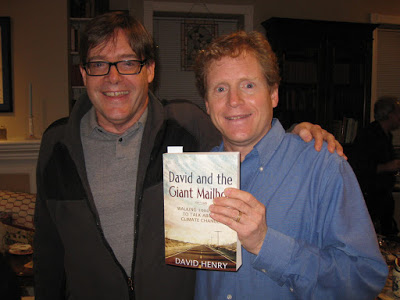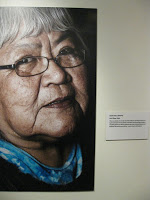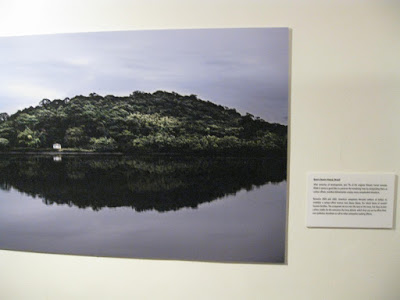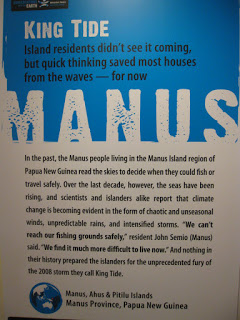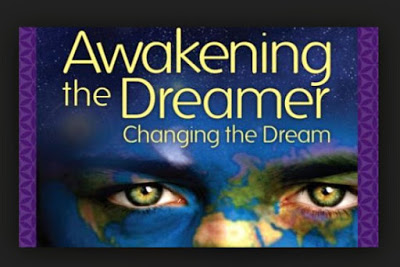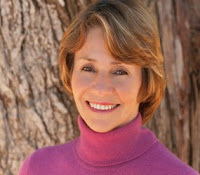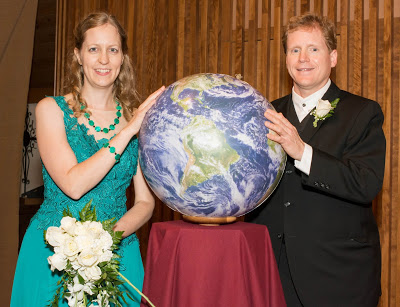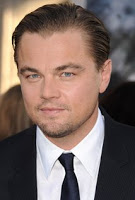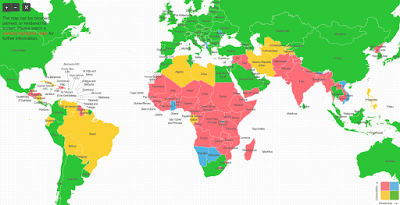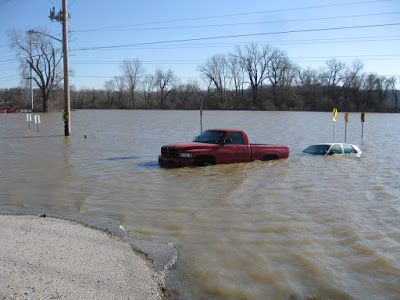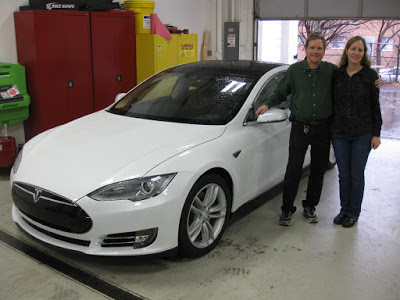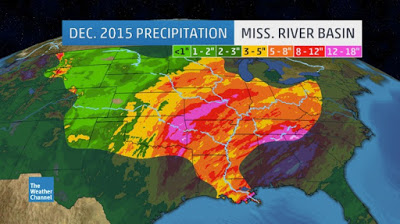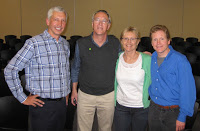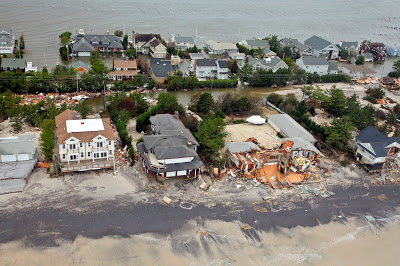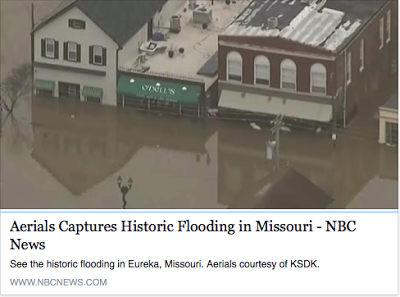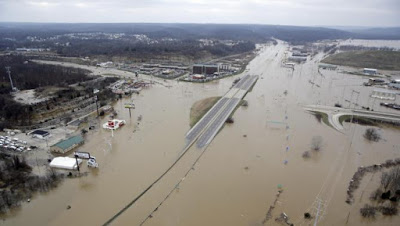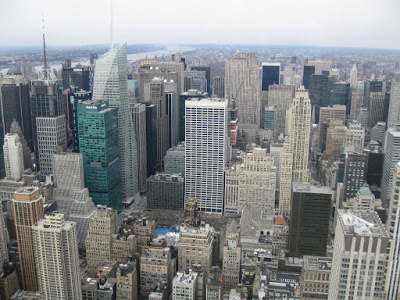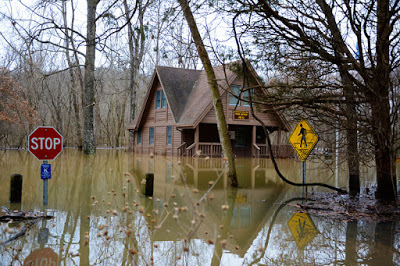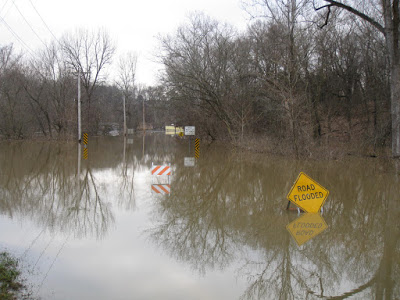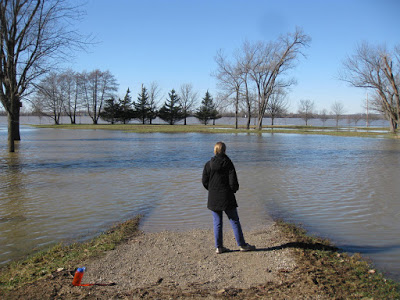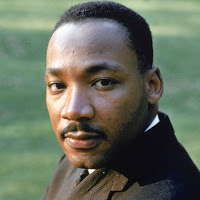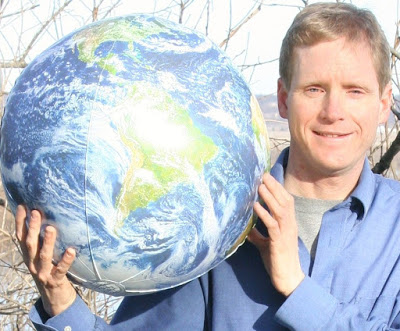I am sure you have heard the expression, ‘It’s not enough to talk the talk, you must walk the walk.’ Basically, speaking out about an issue of deep concern is not enough, we must take action.
My friend David Henry did just that. He walked over a thousand miles to talk to people about climate change. From June to August 2013, David walked by foot from Boston, Massachusetts to South Charleston, Ohio. It’s a distance of 1,042 miles over 60 days. He kept his belongings inside a large covered cart, which people he encountered thought it looked like a giant mailbox. Hence, the title of the book he wrote, David and the Giant Mailbox.
In 2012, David Henry started feeling restless in his home in St. Louis Missouri that he must do something about climate change. He had read enough news reports about extreme weather and learned enough about the science of climate change from sources like skepticalscience.com. Through his interest in this subject, David learned that climate change is real, caused by human activity currently, it impacting people right now, and we must act fast to reduce the nastiest consequences.
It worried David that people did not seem to care. He then discovered how Americans perceive climate change. He read the September 2012 Yale Project for Climate Change Communication published report, Global Warming’s Six Americas. This report based on several public opinion surveys notes that Americans fall into six categories of attitudes on climate change: Alarmed, concerned, cautious, disengaged, doubtful, and dismissive. According to that report, only about 16% of the population was alarmed like David. As far as the other 84% the population, David felt angry they were not as alarmed as him. He wrote,
“I envisioned all of humanity sleepwalking down a narrow path to the edge of a cliff. That made me pissed. I couldn’t just sit back and let it happen. I decided it was time to do something.”
My Struggle to ‘Walk the Walk’
I can totally relate how David felt in 2012. The same awareness about climate change happened to me working during the winter of 2007-08 in Everglades National Park in south Florida. As I share in my current climate change talks and speeches, I became a naturalist park ranger narrating boat tours in Everglades National Park in 1998. At that time, I knew nothing about climate change. However, park visitors were starting to ask me about this global warming thing and they expect park rangers to know everything.
Thus, I went to a Miami bookstore in 1999 my first book on climate change, Laboratory Earth: The Planetary Gamble We Can’t Afford to Lose by the late Dr. Stephen Schneider of Stanford University. I then got hooked reading books and articles about global warming in my spare time. I saw Al Gore’s documentary, An Inconvenient Truth in 2006 and it deepened my interest even more. By the winter of 2007-08, I could not sleep at night working in the Everglades. I felt I had to do something about climate change.
To this day, I still work my summer job at Crater Lake National Park. However, I gave up my winter job in the Everglades to return home to St. Louis for the winter. I had no idea what I was going to do in my hometown. However, I knew I had to speak out, write and organize locally to inspire others to take action to reduce the threat of climate change.
Over 8 years later, I am still trying to figure how to take bold action on climate change. The question that still bothers me is: How can I take enough action to create awareness among Americans to inspire them to take effective action on climate change? How was I going to not just talk the talk but walk the walk so all of us would be inspired to reduce the threat of climate change.
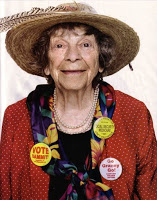 |
| Doris “Granny D” Haddock Image Source: pendemocracy.me |
Part of me thought about walking across country like my friend David. I love to travel and see different parts of the United States. For over 20 years, I have driven across country from Oregon to Florida while working in the national parks. The thought has occurred to me to travel across by foot to see the country more up close. It seemed like such dream adventure too. Forrest Gump walked across country in one of my favorite movies. Doris Haddock, known as “Granny D,” achieved national fame when she walked over 3,200 miles across the United States to advocate for campaign finance reform. She walked from southern California to Washington D.C. from January 1, 1999 to February 29, 2000. Even more, she did it when she was between the ages of 88 and 90!
This is still a dream of mine to walk across the United States. It would be great to see the changing scenery. At night, I would then speak at college campuses, town halls and public meetings about climate change.
In August 2013, I was a mentor at the Climate Reality Project Training in Chicago, Illinois. While mingling with the other attendees during the conference, I met Zac Heffernen. He was one of the organizers for the 2014 Great March for Climate Action. It was a 3,000 mile march that started March 1, 2014 in Los Angeles, California, and ended on November 1, 2014 when marchers arrived in Washington, D.C.
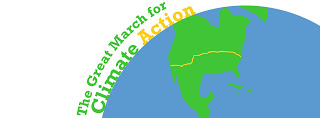 |
| Image Source: climatemarch.org |
In my conversation with Zac, this march sounded like a wonderful idea to raise awareness on climate change while having the safety in numbers and supporting logistics to successfully walk across the U.S. It was very tempting for me to join. Zac was very eager for me to join the march with my experience as a park ranger and climate activist. Despite Zac’s besting persuasion, I turned down the march due because I did not want to give up my summer ranger job at Crater Lake Nat. Park. Even more, I was not thrilled with the idea to be away from then girlfriend/now wife Tanya for many months.
Still, I have thought often about ‘walking a walk’ across the U.S. to raise awareness about climate change and I still may do so one of these days.
Climate Walker David Henry is a lot more courageous than me
Like David’s restlessness, I have struggled for years with the question of what bold action should I take on climate change. What brave act should I do to inspire people to take action on climate change? If climate scientists have been warning us that climate change is a very serious threat to our civilization, then what daring act do I need to take as a climate change communicator and activist to make a difference?
Ironically, I did not think David Henry was so courageous when I first met him a couple of years ago. My impression was that he was friendly, kind, and humble when we met. He introduced himself to me as “the Climate Walker.” Sadly, my first impression was ‘So what!’
Many of us who are climate activists have given ourselves titles and tag lines. Since grabbing the website domain in December 2009, I have called myself the Climatechangecomedian. I do that to promote myself as a public speaker on climate change that is educational, inspiring and entertaining.
My friend Harriet Shugarman calls herself the Climate Mama, since she is mother concerned about her kids’ future living on Earth. Her website climatemama.com focused on informing “Climate Mamas and Papas of all ages from all around the world about the realities of the climate crisis” and inspiring and empowering “Climate Mamas and Papas to work together.”
My Canadian friend Rolly Montpellier calls himself the Boomer Warrior. He gave himself this title because “I’m a Baby Boomer and now a Warrior outraged by the kind of world we’ve created.” His climate change website boomerwarrior.org aims at “Raising Awareness to the vast challenges we face” and then “Creating a Sense of Urgency to galvanize people into positive activism.”
A Facebook friend of mine calls herself CelloMom. Her climate blog CelloMom on Cars is about “The quest for the fuel-efficient car that fits the planet and the budget – and the cello.”
Thus, since I knew climate activists besides David who had given themselves titles, I was not that intrigued that with his climate walker title. However, I got to know David over the last two years as were both volunteers with the local St. Louis group for Citizens’ Climate Lobby (CCL).
As I got to know him, I was more impressed by his kindness and dedication to take action on global warming. In March 2014, he happily agreed to my request to meet with the energy aide of our U.S. Representative, Congresswoman Ann Wagner of Missouri, about climate change when he traveled to Washington, D.C. on business. Even more, David met with me before the trip so he would have a positive meeting with Rep. Wagner’s staff about to lobby them to support CCL’s carbon fee and dividend proposal.
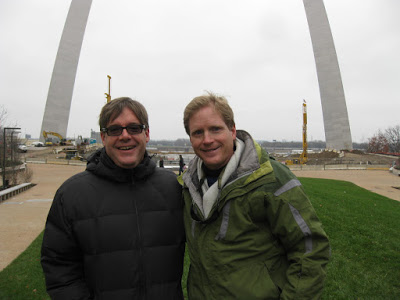 |
| David Henry and Brian Ettling at the People’s Climate March, November 29, 2015 |
When David’s book was published in December 2015, he asked me to read it and give it a review. With my very positive impression on him, I was very happy to oblige.
I quickly discovered reading David and the Giant Mailbox that David Henry IS a lot more courageous than me.
I may pride myself on giving around 100 climate change talks over the past 5 years. In May 2013, Grand Canyon National Park invited me to give my Crater Lake ranger climate talk to an audience of over 200 visitors at their Shrine of the Ages Auditorium. After that talk and many others, I had a few audience members want to fierce argue with me about the science of climate change. I have also given around 15 speeches to my St. Louis South County Toastmasters Club on Climate Change. After the speech, The Debate is Over, I had a question and answer session with a few of the audience members that you can observed on YouTube who are very hostile to the science of climate change. Local businessman Larry Lazar and atmospheric scientist Dr. Jack Fishman of St. Louis University and I gave a live interview on the St. Louis local NPR station on April 15, 2014.
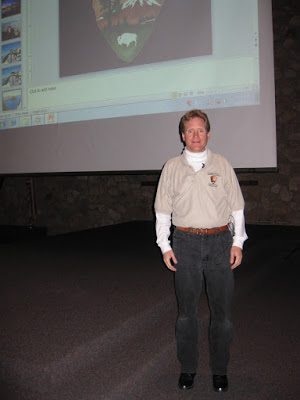 |
| Guest speaker Brian Ettling at Grand Canyon Nat. Park May 7, 2013. |
In December 2014, National Journal interviewed me about giving climate change talks in national parks. I did not think it was so bold at the time. However, a conservative blogger wrote a very critical response, A dose of ideology with your National Park vacation? For a couple of weeks, I worried conservative radio and TV shows would find his blog and they would then start harassing me. Fortunately, no other conservatives noticed the National Journal article or the conservative blogger.
Yes, I have take some bold actions to speak out on climate change awareness and promoting action. However, none of my actions are as brave as David Henry walking over a 1,000 miles to talk about climate change.
Reading David and the Giant Mailbox
The book was a fascinating page turner about David’s 1,042 mile journey on foot. It may been been over 300 pages long, but it was a very quick read. The chapters, averaging about 5 to 6 pages long, were basically an account of what happened each day. As an aspiring cross country hiker, I quickly learned that a cross county hike is not easy.
David had to confront many busy streets with no sidewalks, intense thunderstorms, sore feet, fatigue near the end, sunburn, trying to find a place to camp each night, flat tires on his cart, etc. With all of the frustrations, he add ask himself multiple times if it was worth it to continue.
Friends warned him to be leery of people. However, David found numerous people willing to help him out on a pinch. In his everyday life, David is more of a quiet and reserved guy. Conversations are not always easy for him. In my past interactions with him, David is warm, generous and friendly, Yet, it felt like he was a private individual, not willing to share more than he absolutely had to share.
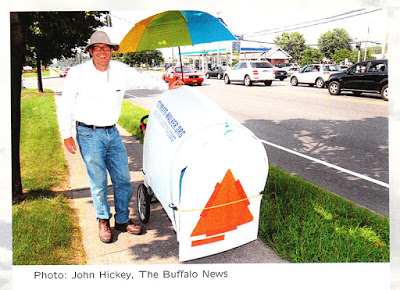 |
| Photo from the back cover of the book David and the Giant Mailbox. |
Therefore, part of the wonder of the book is seeing David break out of his comfort zone and engage people. The cart shaped like a mailbox was an amazing conversation starter or ice breaker for people he encountered. In walking long distances, David got to experience firsthand the Anne Franck quote:
“In spite of everything I still believe that people are really good at heart.”
David’s quote though was not just to walk to meet people. His big goal was to have a conversation with as many people he could find about climate change. His specific plan was to have at least 100 global warming conversations while he walked across the country. As David shares his stories of the conversations, he provides a great example how to converse with people about climate change.
After folks would approach him about what he was doing, David would gently explain he was walking across to create more awareness about climate change. Some folks took a genuine interest, others just changed the subject, some were disinterested and just a few wanted to argue with David in a hostile manner.
In the few cases where folks wanted to strongly disagree with David, he would completely listen to them in a heartfelt way. He would then quietly to try correct their misconceptions about the science by quoting such sources as the Consensus Project, which affirmed that 97% of climate scientists agree climate change is hapening and it is mostly human caused.
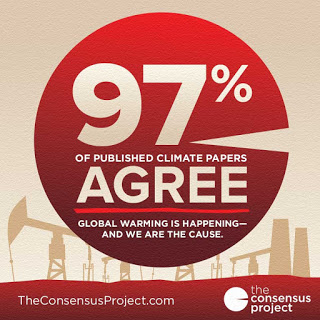 |
| Image Source: mediamatters.org |
Through the book’s recollection of his conversations, David gives a great lesson to not get angry, lecture, or insult the people when he occasionally met people who wanted to engage him in a hostile way. Although he imagined before and during the walk of wanting to grab someone by the scruff of the neck if they dismissed climate change, he never does that. He always tried to find common ground in every interaction while holding on to his conviction that we must act on the climate crisis.
From his courage of taking this long journey by foot and his open heart when encountering people, it felt like even the most hard core climate contrarians seemed like they still found a way to like, help, and even admire David. He found other ways to relate to folks when the conversation of climate change was a non-starter. His audacious walk and friendly interactions gave climate doubters a positive perspective that they do not experience when global warming is mentioned on TV or the radio. Thus, he does become a good ambassador for caring for our planet during his trek.
 |
| Image Source: amazon.com |
From his many interactions, David learned a new faith and optimism for humanity. He witnessed enough good, caring, concerned and open minded people like him that we just may avoid the worst impacts of climate change.
David’s experience reminded me of a quote from Julia Butterfly Hill. She is best known for having living in a 180-foot (55 m)-tall, roughly 1500-year-old California Redwood tree, affectionately known as “Luna,” for two years between December 1997 and December 1999. Hill lived high up in the tree the entire time to prevent Pacific Lumber Company loggers from cutting it down. Julia documented that experience in another book I recommend reading, The Legacy of Luna. The second book wrote by Julia, One Makes a Difference, she proclaimed:
“Eternal optimism joined with loving action is the most powerful tool I own.”
Even if I not able to personally walk across country, David’s bold action gave me optimism that one person (I) can make a difference. Even more, his journey showed that people do have enough good and generosity inside of them that we can reduce the threat of climate change.
David, thank you so much for writing this book.

